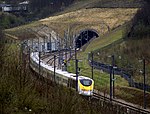Coffin Stone

The Coffin Stone, also known as the Coffin and the Table Stone, is a large sarsen stone at the foot of Blue Bell Hill near Aylesford in the south-eastern English county of Kent. Now lying horizontally, the stone probably once stood upright nearby. Various archaeologists have argued that the stone was part of a now-destroyed chambered long barrow constructed in the fourth millennium BCE, during Britain's Early Neolithic period. If a chambered long barrow did indeed previously exist on the site, it would have been built by pastoralist communities shortly after the introduction of agriculture to Britain from continental Europe. Long-barrow building was an architectural tradition widespread across Neolithic Europe. It consisted of various localized regional variants; one of these was in the vicinity of the River Medway, examples of which are now known as the Medway Megaliths. The Coffin Stone lies on the eastern side of the river, not far from the chambered long barrows of Little Kit's Coty House, Kit's Coty House, and the (now destroyed) Smythe's Megalith. Three other examples, the Coldrum Long Barrow, Addington Long Barrow, and Chestnuts Long Barrow, remain on the western side of the river. The Coffin Stone is a rectangular slab lying flat that measures 4.42 metres (14 ft 6 in) in length, 2.59 metres (8 ft 6 in) in breadth, and about 0.61 metres (2 ft) in width. Two smaller stones lie nearby and another large slab is now located atop it. In the 1830s it was reported that local farmers found human bones near the stone. An archaeological excavation of the site led by Paul Garwood took place in 2008–09; it found that the megalith was placed in its present location only in the 15th or 16th centuries. The archaeologists found no evidence of a chambered long barrow at the location, and suggested that the Coffin Stone might once have stood upright in the vicinity.
Excerpt from the Wikipedia article Coffin Stone (License: CC BY-SA 3.0, Authors, Images).Coffin Stone
Pilgrims Way, Tonbridge and Malling Aylesford
Geographical coordinates (GPS) Address External links Nearby Places Show on map
Geographical coordinates (GPS)
| Latitude | Longitude |
|---|---|
| N 51.317777777778 ° | E 0.49583333333333 ° |
Address
Coffin Stone (Coffin;Table Stone)
Pilgrims Way
ME20 7DD Tonbridge and Malling, Aylesford
England, United Kingdom
Open on Google Maps











